

American Drama 565
Expressionist Art Gallery
Definition:
Expressionism
in drama and art was a movement that offered a critique of modern decadence and rejected traditional
methods of representing objective reality. Instead,
expressionists exaggerated and distorted aspects of the
outside world in order to "express" subjective
moods and feelings. In other words, their landscapes and
portraits were actually "mindscapes." In American
drama, Eugene O'Neill, Elmer Rice, and Sophie Treadwell are noted for their
expressionist plays. Thriving from about 1910 to 1925,
expressionism continues to be an important influence on
experimental theatre and art.
Here is more information on expressionism in the arts.
Forerunners:
Dutch
post-impressionist Vincent Van Gogh used vibrant colors
and curving lines to convey the energy and intense emotion
advocated by the later expressionist artists. They also
admired the emotional impact of the serene colors and
simplification of form in paintings by artists like German
Paula Modersohn-Becker.
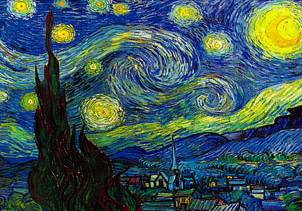
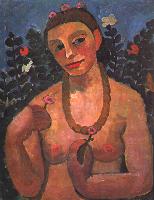
(Left) Vincent Van Gogh, "Starry Night" 1889
(Right) Paula Modersohn-Becker, "Self-Portrait with Amber Necklace" 1906
Independent Expressionists:
Projecting existential anxieties
into a blood-red landscape, "The Scream" (or
"The Cry") by Norwegian Edvard Munch was an icon of
the expressionist movement.
- According to Munch, "I was walking along a path with two friends -- the sun was setting -- suddenly the sky turned blood red -- I paused, feeling exhausted, and leaned on the fence -- there was blood and tongues of fire above the blue-black fjord and the city -- my friends walked on, and I stood there trembling with anxiety -- and I sensed an infinite scream passing through nature."
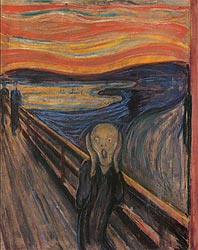
Edvard Munch, "The Scream" 1893
The prints by German Kathe Kollwitz express intense feelings about the horrors of war and the need for compassion and solidarity.
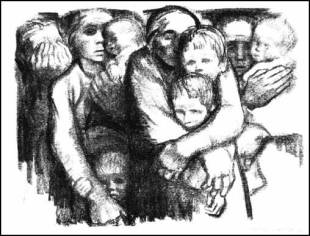
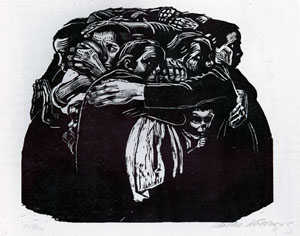
Kathe Kollwitz, (left) "Widows and Orphans" 1919 and (right) "The Mothers" 1921/22

Kathe Kollwitz, "Self-Portrait with Hand on Forehead" 1910
Die Brucke (The Bridge):
This
group of expressionists from Dresden, Germany often used
angular distortions and color to suggest their aversion for
modern, post-industrial society (Ernst Kirchner) or to convey
their preference for a kind of primal innocence in nature
(Otto Muller). They believed that their social criticism of
the ugliness of modern life could act as a "bridge"
to a new and better future. Hitler labeled these painters
(including Grosz, below) "decadent" and banned them
from German art galleries.
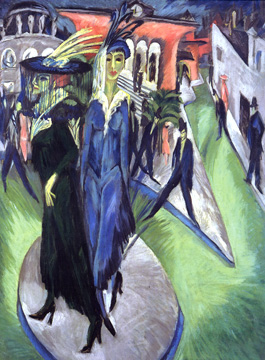
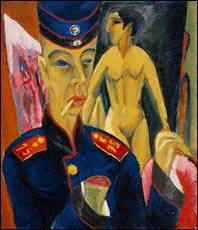
(Left) Ernst Ludwig Kirchner, "Two Women in the Street" 1914
(Right) Ernst Ludwig Kirchner, "Self-Portrait as a Soldier" (Selbstbildnis als Soldat) 1915


Otto Muller, (left) "Zwei Madchen in Grunen Um" 1925 and (right) "Gypsy Lovers"
Note: Muller's name, which in German has an umlaut over
the "u," is variously spelled in English as Muller or Mueller.
Der Blaue Reiter (The Blue
Rider):
This group of expressionists from
Munich, Germany and elsewhere in Europe used symbolic colors
to suggest the spiritual transformation of modern society.
The famous blue horses of Franz Marc (an animal lover) convey
innocence and spirituality, the brownish colors an
inwardness. Gabrielle Munter's portrait relies on similar
colors and simplified shapes to express her subject's inner
self. Russian Wassily Kandinsky's joyous paintings progressed
from color-drenched landscapes to the nonobjective study of
color itself, which made him an important forerunner of the
World War II-era abstract expressionists.
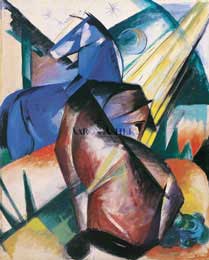

(Left) Franz Marc, "Two Horses" c. 1912 and (right) Gabriele Munter, " Young Polish Woman" 1909
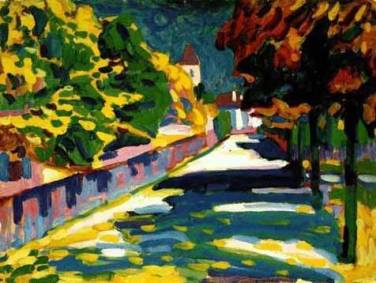
Wassily Kandinsky, "Autumn in Bavaria" 1908

Wassily Kandinsky, "Farbstudie Quadrate" 1913
["Color Study--Squares with Concentric Rings"]
Die Neue Sachlichkeit (The
New Objectivity or New Realism):
Appalled
by the horrors of World War I and the economic depression and
social dislocation in Germany, this group of expressionists
like German Otto Dix painted shocking images of war
atrocities. German artist George Grosz's simplified forms and
colors express negative feelings about the
decadence--prostitution, etc.--of urban life.

Otto Dix, "Lichtsignale" (The Flare) 1917


Georg Grosz, (left) "Metropolis" 1917 and (right) "Lovesick Man" 1916
More Information on Expressionism in the Arts
- Expressionism: An Introduction--expressionism in the arts.
- Expressionisn: Its Spiritual and Social Voice--rise of the art movement and attempted suppression by the Nazis. Good, readable essay. Includes Hitler's failed attempt to become an artist.
- Expressionism in Film--expressionist pioneers in early film.
Background set by: Quest Graphics Design



